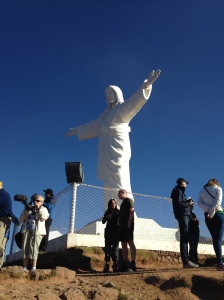July 15, 2014

After a lively, late night dinner with our tour group that included the opportunity to make our own Pisco Sours, surprisingly we were up early for our final morning in Cusco. Our first stop was to Starbucks. Don’t judge. Old habits die hard, and Starbucks has free wifi. And reliable caffeinated beverages. And we wanted to Facetime with our sons. We hadn’t seen their cute little faces in days. We were due.

This Starbucks store sits on the second floor of an old building right off the main plaza, so it offers a nice view of the city while you wait for your latte. While we were sitting there, a procession of local, Catholic school children was making its way down the street in front of the store. Some were dressed in uniforms. Some were in angel costumes. All were adorable. It was one of those scenes you just don’t get to see in suburban Denver, so we snapped a few photos to share with our kids.I don’t feel one bit bad for visiting that highly commercial, Seattle-based coffeehouse. The way I had it figured, we were supporting American workers.

With caffeine on board, we went out to find some final souvenirs before heading to the airport. Walking around the central area in Cusco is fun. The city is both modern and ancient. You’re just as likely to encounter a hip student on a cell phone as you are a woman in traditional dress walking an alpaca. We lucked out and ran into Ray while we were trying to decide the best place to buy some last-minute gifts. It’s great to have a local to give you tips when you’re not familiar with an area. They can be invaluable in suggesting restaurants and pointing you in the right direction for exactly what you need. It helps when that person is also energetic, fun, and an all-around nice person. I was glad to discover that Ray is on Facebook. Facebook, for all its absurdities, makes the world a bit smaller by allowing me to stay in touch with amazing people I meet along my life’s journey.

We got to the airport with time to spare before our scheduled departure. While we were sitting there waiting, Andrew went off to buy some snacks. He returned carrying a bottle of Inca Cola. We’d seen this on the menu nearly everywhere we went. Inca Cola is Peru’s answer to Coca Cola. It looks like Mountain Dew, but Ray told us it tasted like bubblegum. Andrew poured us each a sample in a plastic cup and we toasted to our trip and our successful completion of the Inca Trail. Salud! Turns out it does taste pretty much like bubblegum soda, which I thought would be horrific but really wasn’t as disgusting as I had imagined. Not saying I’ll be buying cases of it on Amazon or anything, but I always figure I’m better for every new thing I’m brave enough to try.

We arrived in Lima hungry and tired. When we checked in at our hotel for our last night, I pulled up TripAdvisor and looked for a restaurant nearby. Saqra was ranked #14 in Lima and, bonus, it was just around the block from the hotel. It was a definite find. The ambiance was modern, fun, and funky, and the food was delicious. Up until that point, the four of us had been fairly conservative about what we ate and drank because, well, we were nervous about being sick on the Inca Trail. But with our trek behind us, all bets were off. We started with our first official Pisco Sours of the trip. The night before we’d sampled them but didn’t commit. I finally understood why people rave about these drinks. They’re tasty, they hit you like a ton of bricks (hello…cheap date here), and despite the lovely buzz there were no ill-effects afterwards. We ordered a couple appetizers, Parmesan scallops (which were served on their lovely shells) and ceviche to start. Perfecto! I settled upon ravioli for my main course and was not disappointed. The most fun part about Saqra was the restrooms, which were infinitely more amusing after a Pisco Sour. There are two unisex rooms. One is decorated with walls covered floor to ceiling in padded, red vinyl. The other room is entirely mirrored. Neither was occupied, so I had my choice. I won’t share which one I drew me in first, but I will tell you that a second Pisco Sour and another glass of agua con gas guaranteed that I eventually got to experience them both. When I got back to the table, as gauche as it is, I mentioned that the restrooms were not to be missed. I was curious to see what room would intrigue my friends. I’m all about initiating spirited (and occasionally inappropriate) dinner conversation among friends.
After dinner, we were worn out from shopping, touring, sampling, flying, drinking, and laughing, so we called it an early night. We had to rest up for our last full day in the City of Kings. Tomorrow we would tour Lima, visit a museum, and enjoy one last Peruvian meal before boarding a red-eye back to the States. As excited as I was to see our boys, I was melancholy about leaving Peru. Or maybe it was merely the effect of my Pisco Sours wearing off.








